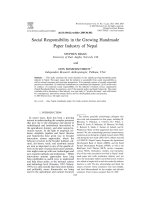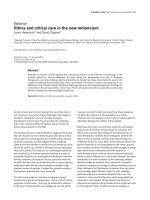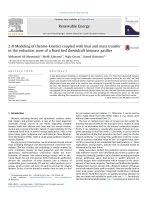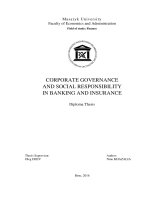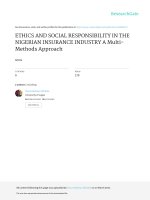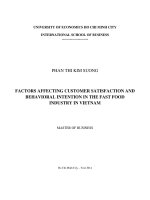Ethics And Social Responsibility In The Nigerian Insurance Industry A Multi-Methods Approach
Bạn đang xem bản rút gọn của tài liệu. Xem và tải ngay bản đầy đủ của tài liệu tại đây (4.44 MB, 392 trang )
Seediscussions,stats,andauthorprofilesforthispublicationat: />
ETHICSANDSOCIALRESPONSIBILITYINTHE
NIGERIANINSURANCEINDUSTRYAMultiMethodsApproach
Article
CITATIONS
READS
0
170
2authors,including:
MusaAdebayoObalola
UniversityofLagos
16PUBLICATIONS35CITATIONS
SEEPROFILE
AllcontentfollowingthispagewasuploadedbyMusaAdebayoObalolaon13March2015.
Theuserhasrequestedenhancementofthedownloadedfile.
ETHICS AND SOCIAL
RESPONSIBILITY IN THE
NIGERIAN INSURANCE INDUSTRY
A Multi-Methods Approach
MUSA ADEBAYO OBALOLA
THESIS SUBMITTED IN PARTIAL FULFILMENT OF THE
REQUIREMENTS OF DE MONTFORT UNIVERSITY,
LEICESTER, FOR THE DEGREE OF DOCTOR OF PHILOSOPHY
SEPTEMBER 2010
i
ABSTRACT
The concern about how business should behave as one of the dominant institutions in
society, widely referred to as corporate social responsibility, has been a subject of
interest among academics and practitioners all over the world. The increasing global
outlook of business activities and the need to understand environments in most parts of
the globe have also made this concept relevant for all time. This thesis therefore relates
to a study, which assesses the perceived role of ethics and social responsibility for
organisational effectiveness in a developing and African country. It was argued that
ethics and social responsibility must first be perceived to be important for business
success, before managers‘ behaviour can become ethical and reflect greater social
responsibility.
Using a mainly qualitative approach and aided by some quantitative analysis, the study
explored the perceived importance of this construct (ethics and social responsibility) for
organisational effectiveness among insurance managers in the Nigerian insurance
industry. This exploration and the analysis are based on the theoretical assumptions that
personal and situational factors do influence managers‘ perception of the importance of
ethics and social responsibility and its business assumption. These, therefore, constitute
major outcomes of the study.
Given that the study is the first of its kind in the insurance industry, and Nigeria, a
developing economy, its outcomes further aids our understanding of how managers in
an African socio-economic context perceive the construct and their readiness to translate
it into business practice. Above all, the thesis demonstrates that the perceived
importance of ethics and social responsibility for organisational effectiveness is a
function of industry and product nature, individual moral values, corporate ethical
values and organisational commitment. The findings suggest that meeting customers‘
expectations reinforce trust-relationship, which in turn is moderated by some other
personal-situational factors. The findings also indicate that highly idealistic managers
were more sympathetic towards the welfare of others, and have higher perception of the
important role of ethics and social responsibility for business success.
ii
ACKNOWLEDGEMENTS
Man as a being is characterised by insufficiency and dependence on others for accomplishment of goals
and objectives. Mine has not been an exception. On this note, therefore, I do acknowledge those who have
contributed to making this thesis a success. Foremost, I do express my profound gratitude to God for His
immense and immeasurable favour on me. I am equally greatly indebted to my supervisors Professor
David Crowther and Professor Elaine Harris for their guidance and support from the inception of the
programme through to its end. From each of them I have learnt useful lessons about academic life. The
invaluable assistance received from Professor Martyn Denscombe, Professor Ian Worthington, Dr.
Kumba Jallow, other members of the Accounting & Finance Department, the entire Business School, the
Research Office, and my fellow research students are also recognised and appreciated. I do also
acknowledge the great assistance rendered by L. Baruwa, F. K. Lawal, W. Fatoyinbo, I. Muslim, M. F.
Apampa, T Sekoni, K. I. Ishola (late), W. Banire, E. Anikibe, Segun Balogun, O. Chilekezi, A. Ajibowo,
S, Olalere, F. Asenuga, Yinka Akintayo, T. Shotonade, M. Adeduro, K. A. Bello, B. Adedigba, M.
Akinwunmi, and others, in facilitating my access to their organisations during the field work of the study.
To all the respondents to the interviews and questionnaires I also say, thank you.
I do acknowledge the support of my parents Alh. Ganiyyu Obalola and Fadhillah Obalola, my siblings,
Sulayman, Lukman, Bilqis, Dawud, A/Hakeem, and Maryam, my brother-in-law, Deji Mustapha, and his
wife, my friends; I. Ibrahim, K. Omoteso, I. Adelopo, A. Mobolaji, T. Yusuf, S. Elegbede, U. Adeyemi,
A. Yusuf, M. Adeyoola, Elfatih Ibrahim, M. Kadri, S. Olagunju, M. Tijani, H. Thani, A. Adenowo, I.
Akosile, A Husein, A. A/Salaam, A. Atitebi, A. Sulaimon, O. Kuye, S. Shitta, I. Badmus, D. Shafi, A.
Abebefe, Y. A/Rahman, S. Ogunmuyiwa, A. Oyeniku, A. Ajibade, S. Alimi, A. Agbelekale, D.
Arogundade, A, Shua‘ib, A. Amida, A. A/Yakeen Madan, and other friends whom I am constrained by
space to mention.
I am profoundly grateful to my former head of Department, Dr. K. Ojikutu, for his encouragement to
pursue a PhD degree and his unflinching support since I joined the academia, and my immediate past
HOD, Dr. J. Mojekwu, the current HOD, Dr. Ibiwoye for their support, as well as my colleagues in the
Department (Professor Ayorinde, Dr. Hamadu, Dr. Adeleke, Obiwuru, Aduloju, Falade, Olowokudejo,
Ndubusi, Isimoya, Ajijola, Akinbami, Shokoya etc) and the entire Faculty of Business Administration. I
also want to say a big thank you to Dr. G. Gbadamosi for his incalculable and invaluable support during
the course of this programme. A special appreciation also goes to Olayiwola Baruwa and Poly Emenike,
Dr. Dabo, Isegen, Hon. Abdul-Hakeem, Wasiu Fatoyinbo for their moral and financial support in the
course of the programme.
Lastly, I would like to acknowledge my debt to my darling wife, Fatimah for her unflinching love,
support, patience, and care for the children, and my children Mus‘ab, Khalid, Muhammad, and Khadijah
for bearing my absence from home with patience, and love.
iii
CONTENTS
ABSTRACT ......................................................................................................................ii
ACKNOWLEDGEMENTS .............................................................................................iii
CONTENTS ..................................................................................................................... iv
LIST OF TABLES............................................................................................................. x
LIST OF FIGURES.........................................................................................................xii
LIST OF ABBREVIATIONS .........................................................................................xiii
CHAPTER 1:
1.1
INTRODUCTION AND BACKGROUND INFORMATION ............ 1
Introduction ........................................................................................................ 1
1.1.1
Background Information ............................................................................. 1
1.1.2
Ethics and Social Responsibility: Construct Definition .............................. 3
1.2
Aims of the Study ............................................................................................... 4
1.3
Objectives of the Study ...................................................................................... 5
1.3.1
Research Questions ..................................................................................... 5
1.3.2
Research Propositions ................................................................................. 6
1.4
Scope of the Study .............................................................................................. 7
1.5
Relevance of the Study ....................................................................................... 7
1.6
Contribution to Knowledge ................................................................................ 9
1.7
The Nigerian Insurance Industry ...................................................................... 10
1.8
Conclusion ........................................................................................................ 12
CHAPTER 2:
NATURE OF INSURANCE SERVICES AND THE NIGERIAN
INSURANCE INDUSTRY ............................................................................................. 14
2.1
Introduction ...................................................................................................... 14
2.1.1
Insurance as a Concept and Practice ......................................................... 14
2.1.2
How Does Insurance Work? ...................................................................... 16
2.1.3
Insurance and the Law .............................................................................. 17
2.1.4
Insurance as a Contract and its Complexity .............................................. 22
2.2
Insurance and Information Asymmetry ............................................................ 23
2.2.1
The Effect of Information Asymmetry on the Consumers of Insurance ... 24
2.3
The Role of Insurance Intermediaries .............................................................. 26
2.4
The Nigerian Insurance Market ........................................................................ 27
2.5
The Insuring Culture in Nigeria ....................................................................... 30
iv
2.6
Business Practice in the Nigerian Insurance Industry ...................................... 30
2.7
Beyond Mere Good Business Practice ............................................................. 33
2.8
Conclusion ........................................................................................................ 35
CHAPTER 3:
ETHICS AND CORPORATE SOCIAL RESPONSIBILITY ........... 37
3.1
Introduction ...................................................................................................... 37
3.2
Overview of Ethics and Social Responsibility ................................................. 37
3.2.1
Business and Society: what is the relationship? ........................................ 38
3.2.2
Defining Corporate Social Responsibility (CSR) ..................................... 40
3.2.3
Competing Concepts of Business-Society Relationship ........................... 50
3.2.4
Schools of Thought and Theories on Corporate Social Responsibility .... 51
3.2.5
Competing theories of CSR ...................................................................... 53
3.2.6
Classifying the Array of Definitions ......................................................... 59
3.2.7
The Position of this Study ......................................................................... 62
3.3
Strategic Dimension of Social Responsibility .................................................. 63
3.3.1
Ethics and Social Responsibility, and Organisational Effectiveness ........ 64
3.3.2
The Perceived Role of Ethics and Social Responsibility .......................... 68
3.4
Theoretical Framework .................................................................................... 75
3.4.1
Deontology and Teleology ........................................................................ 75
3.4.2
Relativism and Idealism ............................................................................ 80
3.4.3
Organisational Environment and Ethical Decision-making ...................... 84
3.4.4
Organisational Commitment and Ethical Decision-making ..................... 85
3.4.5
Culture and Ethical Decision-Making ....................................................... 87
3.5
The Gap in the Literature ................................................................................. 92
3.6
Conclusion ........................................................................................................ 93
CHAPTER 4:
THE RELEVANCE OF ETHICS AND SOCIAL RESPONSIBILITY
IN INSURANCE 94
4.1
Introduction ...................................................................................................... 94
4.1.1
Financial Services Sector and Ethical Issues ............................................ 94
4.2
The Insurance Industry ..................................................................................... 95
4.3
Ethics and Trust ................................................................................................ 96
4.4
Trust Relationship and Insurance ..................................................................... 98
4.5
The Regulation of Financial Services............................................................. 104
v
4.6
Empirical Evidence of Ethical Dilemma in the Insurance Industry ............... 105
4.7
State Regulation vs. Self Regulation: The Case for Social Responsibility .... 109
4.8
Conclusion ...................................................................................................... 111
CHAPTER 5:
5.1
THE INDUCTIVE PROCESS......................................................... 113
Introduction .................................................................................................... 113
5.1.1
Philosophical Discourse .......................................................................... 113
5.1.2
Competing Paradigms in Management and Organisational Research .... 115
5.1.3
Multiple Approach to Research ............................................................... 122
5.2
Research Questions and Propositions............................................................. 126
5.2.1
Research Questions ................................................................................. 126
5.2.2
Research Propositions ............................................................................. 127
5.3
Research Design ............................................................................................. 127
5.3.1
The Subjects ............................................................................................ 130
5.3.2
Interview Questions ................................................................................ 131
5.3.3
Data Collection........................................................................................ 132
5.4
Data Analytic Procedures ............................................................................... 134
5.4.1
5.5
Qualitative Data: Interviews ................................................................... 134
Validity and Reliability of the Instrument ...................................................... 135
5.5.1
The Qualitative Data ............................................................................... 135
5.6
Limitations of the Methodology ..................................................................... 136
5.7
Conclusion ...................................................................................................... 137
CHAPTER 6:
THE ROLE OF ETHICS AND SOCIAL RESPONSIBILITY IN
INSURANCE BUSINESS: THEORY AND DATA EVIDENCE ................................ 138
6.1
Introduction .................................................................................................... 138
6.1.1
Re-statement of Research Questions and Propositions ........................... 139
6.1.2
Instrumentation ....................................................................................... 140
6.1.3
Descriptive Characteristics of the interviewees ...................................... 140
6.2
The Interviewees‘ Organisations .................................................................... 142
6.2.1
Analysis of Interviewees‘ Companies in the Industry............................. 142
6.2.2
Critical Success Factors (CSFs) .............................................................. 143
6.3
Meaning of Ethics and Social Responsibility................................................. 145
6.4
The Perceived Role of Ethics and Social Responsibility ............................... 150
vi
6.5
Important Role of Ethics and Social Responsibility: ‗Why‘ and ‗How‘ ........ 152
6.5.1
Comparison of Ethics and Social Responsibility to other Measures of
Effectiveness .......................................................................................................... 160
6.6
Moderating Factors of the Perceived Importance of Ethics and Social
Responsibility ............................................................................................................ 169
6.7
Summary ........................................................................................................ 177
6.8
Conclusion ...................................................................................................... 179
CHAPTER 7:
THE DEDUCTIVE PROCESS ....................................................... 180
7.1
Introduction .................................................................................................... 180
7.2
Further Research Questions and Propositions ................................................ 180
7.2.1
Research Questions ................................................................................. 180
7.2.2
Research Propositions ............................................................................. 181
7.3
The Population and Samples .......................................................................... 184
7.3.1
7.4
Selection of Samples ............................................................................... 186
The Measuring Instruments ............................................................................ 189
7.4.1
PRESOR.................................................................................................. 189
7.4.2
Ethics Position Questionnaire (EPQ) ...................................................... 192
7.4.3
Corporate Ethical Value (CEV) ............................................................... 194
7.4.4
Organisational Commitment Scale ......................................................... 195
7.5
The Survey Questionnaire .............................................................................. 196
7.6
The Research Variables .................................................................................. 197
7.6.1
Dependent Variables................................................................................ 197
7.6.2
Independent Variables ............................................................................. 198
7.7
Data Collection ............................................................................................... 199
7.8
Procedures for Data Analysis ......................................................................... 200
7.9
Validity and Reliability of the Instrument ...................................................... 202
7.10
Limitations of the Deductive Process ............................................................. 203
7.11
Conclusion ...................................................................................................... 205
CHAPTER 8:
PERSONAL-SITUATIONAL FACTORS AND THE PERCEIVED
ROLE OF ETHICS AND SOCIAL RESPONSIBILITY ............................................. 206
8.1
Introduction .................................................................................................... 206
8.2
Data Cleaning and Descriptive Statistics ....................................................... 206
vii
8.2.1
8.3
Demographic Characteristics of the Sample ........................................... 209
Factor Analysis ............................................................................................... 211
8.3.1
PRESOR.................................................................................................. 211
8.3.2
EPQ ......................................................................................................... 213
8.3.3
CEV ......................................................................................................... 216
8.3.4
Organisational Commitment Scale ......................................................... 218
8.4
Reliability Analysis ........................................................................................ 219
8.4.1
PRESOR.................................................................................................. 219
8.4.2
EPQ ......................................................................................................... 220
8.4.3
CEV ......................................................................................................... 220
8.4.4
Organisational Commitment Scale ......................................................... 221
8.5
Correlation Analysis ....................................................................................... 221
8.6
Regression Analysis ....................................................................................... 225
8.6.1
Moral Values and the Perceived Role of Ethics and Social Responsibility-
Model 1 226
8.6.2
Moral Values, Corporate Ethical Values, Organisational Commitment, and
PRESOR – Model 2 ............................................................................................... 232
8.6.3
Validating the Results of the Regression Models 1 and 2 ....................... 236
8.6.4
Model Parsimony .................................................................................... 238
8.6.5
The Effect of Demographic and Job Characteristics on PRESOR.......... 240
8.7
Summary ........................................................................................................ 241
8.8
Conclusion ...................................................................................................... 245
CHAPTER 9:
SUMMARY, DISCUSSION AND CONCLUSIONS ..................... 246
9.1
Introduction .................................................................................................... 246
9.2
Summary of the Chapters ............................................................................... 248
9.3
Discussion of Findings ................................................................................... 251
9.3.1
Business Performance and Critical Success Factors ............................... 251
9.3.2
Meaning of Ethics and Social Responsibility ......................................... 252
9.3.3
The Perceived Role of Ethics and Social Responsibility ........................ 255
9.3.4
Short-term Profitability vs. Long-term Profitability and Survival .......... 256
9.3.5
Individual Moral Values as Drivers of Ethics and Social Responsibility 258
viii
9.3.6
Corporate Ethical Values and the Perceived Importance of Ethics and
Social Responsibility ............................................................................................. 260
9.3.7
Organisational Commitment and the Perceived Importance of Ethics and
Social Responsibility ............................................................................................. 262
9.4
Implications of Findings for the Insurance Industry ...................................... 263
9.5
Beyond the Study Samples ............................................................................. 268
9.6
The Contribution of the Thesis ....................................................................... 268
9.6.1
A Developing Economy Context of the Perceived Role of Ethics and
Social Responsibility ............................................................................................. 269
9.6.2
Determinants of the Perceived Role of Ethics and Social Responsibility
270
9.6.3
Methodological Robustness .................................................................... 271
9.7
Reflecting on the Research Process ................................................................ 272
9.8
Limitations of the Study ................................................................................. 273
9.9
Direction for Future Research ........................................................................ 274
9.10
Conclusion ...................................................................................................... 275
REFERENCES.............................................................................................................. 277
BIBLIOGRAPHY ......................................................................................................... 321
APPENDICES .............................................................................................................. 323
ix
LIST OF TABLES
CHAPTER THREE
Table 3.1: Forsyth‘s Taxonomy of Personal Moral Philosophies ............................ 82
CHAPTER FIVE
Table 5.1: Philosophical assumptions of positivism .............................................. 117
Table 5.2: Comparison of positivism and interpretivism paradigms ..................... 119
CHAPTER SIX
Table 6.1: Demographic Characteristics of the Interviewees ................................ 141
Table 6.2: Descriptive Statistics of the Interviewees ............................................. 141
CHAPTER SEVEN
Table 7.1: List of Insurance Firms in Victoria Island (VI) ........................................ 188
Table 7.2: List of Insurance Firms in Lagos Island (LI) ............................................ 188
Table 7.3: List of Insurance Firms in Lagos Mainland (LM) .................................... 189
Table 7.4: Variables, scale items and reliability of the PRESOR sub-scales............. 191
Table 7.5: Variables, scale items and reliability of the EPQ sub-scales .................... 193
Table 7.6: Variables, scale items and reliability of the CEV sub-scale. .................... 194
Table 7.7: Variables, scale items and reliability of the organisational commitment
scale. .......................................................................................................................... 196
CHAPTER EIGHT
Table 8.1: Normality Test for the PRESOR – Dependent Variables ......................... 207
Table 8.2: Descriptive Statistics of PRESOR – Dependent Variables ....................... 207
Table 8.3: Descriptive Statistics of EPQ, CEV & Org. Commit. – Independent
Variables .................................................................................................................... 208
Table 8.4: Demographic Characteristics of Respondents .......................................... 210
Table 8.5: KMO and Bartlett‘s Test for PRESOR ..................................................... 212
Table 8.6: Rotated and Unrotated Factor loadings of PRESOR ............................... 212
Table 8.7: Comparison of the Actual Eigenvalues with the Parallel Analysis for
PRESOR .................................................................................................................... 213
Table 8.8: KMO and Bartlett‘s Test for EPQ............................................................. 215
Table 8.9: Unrotated and Rotated Factor Loadings of EPQ ...................................... 215
x
Table 8.10: Comparison of the Actual Eigenvalues with the Parallel Analysis for EPQ
................................................................................................................................... 216
Table 8.11: KMO and Bartlett‘s Test for CEV ......................................................... 217
Table 8.12: Unrotated and Rotated Factor Loadings of CEV .................................. 217
Table 8.13: Comparison of the Actual Eigenvalues with the Parallel Analysis for
CEV ............................................................................................................................... 217
Table 8.14: KMO and Bartlett‘s Test for Organisational Commitment Scale ........... 218
Table 8.15: Unrotated Factor Loadings for Organisation Commitment Scale .......... 218
Table 8.16: Comparison of the Actual Eigenvalues with the Parallel Analysis for Org.
Commit. Scale ........................................................................................................... 219
Table 8.17: Cronbach‘s Alpha Values for the Study‘s Scales .................................... 220
Table
8.18:
Inter-Item
Correlation
Matrix
for
CEV
as
Uni-dimensional
Scale...........................................................................................................................221
Table 8.19: Correlations between the Dependent and Independent Variables .......... 223
Table 8.20: Scale items for PRESOR 1, 2 and 3 ....................................................... 226
Table 8.21: Multiple regression analysis of the PRESOR subscales – Model 1 ....... 229
Table 8.22: Multiple regression analysis of the PRESOR subscales – Model 2 ....... 235
Table 8.23: Cross-validation of the Models Using Adjusted R Square ..................... 237
Table 8.24: Cross-validation of the Models Using Sample Split (Model 1) ............. 238
Table 8.25: Cross-validation of the Models Using Sample Split (Model 2) ............. 238
Table 8.26: Stepwise multiple regression analysis of the PRESOR subscales – Model
2 Extension ................................................................................................................ 239
Table 8.27: Multiple regression analysis of the PRESOR subscales and the
Demographics
................................................................................................................................... 241
Table 8.28 Summary of the proposed relationships and the outcomes ..................... 244
xi
LIST OF FIGURES
CHAPTER THREE
Figure 3.1: Venn Diagram of CSR theories ............................................................... 59
Figure 3.2: Approaches of Organisational Effectiveness ............................................ 67
Figure 3.3: Normative Ethical Theories ...................................................................... 77
Figure 3.4: Hunt-Vitell Theory of Ethics ................................................................... 80
Figure 3.5: Relationship between Forsyth‘s Moral Philosophies and Normative
Ethical Theories ............................................................................................................. 83
Figure 3.6: Theoretical Framework............................................................................ 88
CHAPTER FIVE
Figure 5.2: The Sequential Triangulation Design ......................................................... 129
CHAPTER SIX
Figure 6.1: Process of analysis .................................................................................. 139
CHAPTER SEVEN
Figure 7.1: Conceptual Framework ........................................................................... 184
CHAPTER NINE
Figure 9.1: The Outcome Conceptual Framework .................................................... 266
xii
LIST OF ABBREVIATIONS
ANOVA
AR
ATBEQ
BC
CC
CCI
CCR
CED
CEO
CEV
CFA
CI
CR
CSF
CSP
CSR
CSR
CSR
EFA
EPQ
FSA
GNP
HND
H-V
IFA
IMSA
KMO
LI
LM
NGT
NIA
NICOM
OE
OND
PCA
PR
PRESOR
SD
SEC
SPSS
VI
ANALYSIS OF VARIANCE
AUTHORISED REPRESENTATIVES
ATTITUDE TOWARDS BUSINESS ETHICS
BUSINESS CITIZENSHIP
CORPORATE CITIZENSHIP
CORPORATE COMMUNITY INVOLVEMENT
CORPORATE COMMUNITY RELATIONS
COMMITTEE FOR ECONOMIC DEVELOPMENT
CHIEF EXECUTIVE OFFICER
CORPORATE ETHICAL VALUE
CONFIRMATORY FACTOR ANALYSIS
CONFIDENCE INTERVAL
CORPORATE RESPONSIBILITY
CRITICAL SUCCESS FACTOR
CORPORATE SOCIAL PERFORMANCE
CORPORATE SOCIAL RECTITUDE
CORPORATE SOCIAL RESPONSIBILITY
CORPORATE SOCIAL RESPONSIVENESS
EXPLORATORY FACTOR ANALYSIS
ETHICS POSITION QUESTIONNAIRE
FINANCIAL SERVICE AUTHORITY
GROSS NATIONAL PRODUCT
HIGHER NATIONAL DIPLOMA
HUNT AND VITELL
INDEPENDENT FINANCIAL ADVISER
INSURANCE MARKETPLACE STANDARD ASSOCIATION
KAISERR-MEYER-OLKIN
LAGOS ISLAND
LAGOS MAINLAND
NORMINAL GROUP TECHNIQUE
NIGERIAN INSURERS ASSOCIATION
NATIONAL INSURANCE COMMISSION OF NIGERIA
ORGANISATIONAL EFFECTIVENESS
ORDINARY NATIONAL DIPLOMA
PRINCIPAL COMPONENT ANALYSIS
PUBLIC RESPONSIBILITY
PERCIEVED ROLE OF ETHICS AND SOCIAL RESPONSIBILITY
STANDARD DEVIATION
SECURITY AND EXCHANGE COMMISSION
STATISTICAL PACKAGES FOR SOCIAL SCIENCE
VICTORIA ISLAND
xiii
CHAPTER 1:
1.1
INTRODUCTION AND BACKGROUND INFORMATION
Introduction
The central theme of this thesis relates to the perceptions managers in the insurance
industry have about the role of ethics and social responsibility in organisational
effectiveness. This chapter thus serves as a route map for the argument of this thesis by
giving the general background information, the problem statement, the research
objectives and questions, the relevance, theoretical perspective, methodology, and
industry context of the study. The chapter also provides the scope of the study, and how
the argument unfolds in the remaining chapters of the thesis.
1.1.1
Background Information
The concern about how business should behave as one of the dominant institutions in
society has captured the attention of both academics and practitioners, and has
generated heated argument and debate. This concern, termed corporate social
responsibility (CSR), relates to the role and obligations expected of business as a
creation of modern society. Two distinct schools have emerged during the early birth of
the concept, one arguing the legitimacy and the other illegitimacy of business assuming
any role in society beyond its primary economic role. The war between the two schools
seems to gradually be coming to an end, with those arguing for the legitimacy of
business engagement in CSR having an upper hand (Carroll and Buchholtz, 2006). This
supposed victory is evident in the way businesses of varying sizes and different
concerns are competing to be seen as socially responsible (Crowther, 2004; Obalola,
2008). Social responsibility has now become the rhetoric of every business; from small
and medium enterprises to big corporations, indigenous corporations to multinationals,
and from profit-oriented to not-for-profit organisations.
The current impetus for CSR engagement and reporting suggests that the concept has
moved beyond the initial stage of conceptualisation, theory building and testing, to
justification and instrumentation, and acceptance. However, the current wave of
scandals among corporations has again re-awakened the keen interest of academics on
what the concept actually means to corporations, and the need to examine its perceived
1
role. The substance of social responsibility of business corporations arises largely from
concern for the ethical consequences of their actions as they may affect the interests of
others (Davis, 1967). However, given the spate of amoral behaviour that permeates the
corporate world today, one tends to wonder if the war has actually been won by the
advocates of social responsibility as a legitimate business concern, or is it just a case of
renewed strategy by the detractors of CSR who masqueraded as business managers.
If current trends in socially irresponsible behaviour go beyond victory between these
two schools, then it may be a case of only focusing on how business might be conducted
responsibly, and not the sufficiency of such responsibility (Gowri, 2004). Put
differently, it may just be a case of choosing between the necessary condition and
sufficient condition of social responsibility. Where corporations have largely been
deemed socially responsible in terms of economic performance, legal compliance and
charitable giving, yet engage in questionable activities, then it equates with a necessary,
and not a sufficient condition.
The necessary condition of social responsibility is capable of drifting towards
irresponsible behaviour, particularly when the incentives for economic goals are the
driving force and this is done within the law. In other words, if the law allows for
corporations to get away with opportunistic behaviours, such as deceiving customers,
swindling investors, exploiting employees, putting consumers at risk and poisoning the
environment (Vogel, 1992), these corporations might be deemed to be acting socially
irresponsibly, even if they engage in philanthropic giving. Therefore, for corporations to
meet the sufficient condition of social responsibility, they must, while pursuing
economic goals, abide by the law, engage in charitable giving, support local
communities, and generally maintain standards of honesty and integrity (Campbell,
2007).
Most service corporations, due to the abstract and convoluted nature of their products,
have a high tendency to drift into amoral behaviour; hence, the necessary condition of
social responsibility. To be more specific, the insurance industry, the industry context of
this study, has been found to engage in opportunistic and amoral behaviour due to the
2
complex nature of insurance products, its special characteristics, and information
asymmetry (Dunfee and Gunther, 1999; Lamb, 1999). The necessary condition of social
responsibility (a limited view of CSR), which the industry seems to have embraced, is
having negative consequences on the industry, and inevitably jeopardising its economic
goals as exemplified in low patronage of insurance products, at least, in the country
context of this study – Nigeria.
What is therefore argued in this thesis is the sufficient condition of social responsibility,
or what Campbell (2007), described as the behavioural threshold, below which
corporations become socially irresponsible. Emphasis on this view of CSR is reflected
in the way the concept has been referred to throughout this thesis, i.e. ―ethics and social
responsibility‖. Various empirical findings have suggested that imbibing this sufficient
condition of social responsibility, or what has also been described as total responsibility,
is not contrary to business interests, but favourable to them. Engaging in this total social
responsibility (Carroll and Buchholtz, 2006) has been held plausible, only if it is
perceived that some benefits would accrue to the corporation. Put differently, naturally,
corporations must perceive ethics and social responsibility to be important before their
behaviours become ethical and reflect greater social responsibility - sufficient condition
of social responsibility (Singhapakdi et al., 1996; Vitell et al., 2003).
1.1.2
Ethics and Social Responsibility: Construct Definition
The controversy between CSR and ethics in terms of which is broader, and which can
be integrated or embedded in the other is well noted in the literature. As noted by Fisher
(2004), it is not uncommon to find in the literature the two concepts interchangeably
used. Whilst ethics and social responsibility do share common traits, the author of this
current work shares the view that understanding of business ethics can enhance
understanding of CSR. In fact, there are definitions in the CSR literature that claim that
the substance of CSR has developed from ethics. For instance, Davis (1967: 46) argues
that ―the substance of social responsibility arises from concern for the ethical
consequences of one‟s action as they may affect the interest of others‖. Similarly,
Epstein (1987: 104) asserted that ―the normative correctness of the products of
corporate action has been the main focus of corporate social responsibility‖ does
3
suggest that ethics and social responsibility shared some overlap. As capped by Samson
and Daft (2003: 147)1, ―ethics deals with internal values that are part of corporate
culture and shapes decisions concerning social responsibility with respect to the
external environment‖.
Having said that, it must be pointed out that the author of this study has no intention of
wading into this controversy, the use of the term ―ethics and social responsibility‖ is
intended as a single construct. The combination of the two terms as a single construct is
informed by the need to operationalise the definition adopted in the study, and also draw
a special attention to the aspect of business conduct that seems to have been largely
ignored in the industry context of the study. In essence, the broader concept is CSR,
while ethics is given special emphasis as one of its dimension. But, it must also be
pointed out that in doing so, the discourse and the argument about the construct might
unintentionally stray into a discourse of business ethics. Nonetheless, the author of this
work believed that there is ethical responsibility as a component of CSR, which is
lacking in the Nigerian insurance industry, considering the fact that the philanthropic
dimension of the concept has already been demonstrated, and is visible in management
practice within the industry.
1.2
Aims of the Study
This study is largely exploratory in nature, and is intended to examine the extent to
which ethics and social responsibility is perceived to play an important role in the
corporations‘ quest for success. It also examines the situational and individual factors
that moderate this perception. Inasmuch as it is the individuals in corporations that
make business decisions, the views being examined here, therefore, are those of
managers in the insurance industry. As part of the gap identified, this exploratory study
uses qualitative method, and afterwards supported with a quantitative analysis. To this
effect, the quantitative data plays a supportive and secondary role, whilst the qualitative
data set plays a primary role. To address the primary aim of this study, the qualitative
data set will be used to elicit a deeper and local understanding of the construct of
interest, and how it is reflected in business practices within the insurance industry. In
1
Quoted in Fisher (2003)
4
order to achieve the secondary aim, a quantitative data set will be used to examine the
theory of ethical decision-making, which depicts personal and situational factors as its
correlates. With these factors first emerging from the qualitative data set, their
examination in light of quantitative analysis would allow for cross-validation of the
results and enhancement of their generalisation.
1.3
Objectives of the Study
Following the aims for which this thesis is intended, and based on the gap in
knowledge, identified through the review of relevant literature, the following objectives
are stated to guide the research.
To examine the perception of insurance managers in Nigeria concerning the
importance of ethics and social responsibility in achieving organisational
effectiveness.
To describe the personal and situational factors that influence this perception.
To evaluate the response of the Nigerian insurance industry to ethics and social
responsibility.
1.3.1
Research Questions
In order to accomplish the aims and objectives of this study, and enhance the coherence
and focus of this thesis, the following research questions are explored.
What do ethics and social responsibility mean to managers in the Nigerian
insurance industry?
What role do these concepts play in business within the insurance industry? Do
ethics and social responsibility play an important role in the Nigerian insurance
industry?
Why and how is ethics and social responsibility important in the insurance
industry?
What are the personal and situational factors that affect managers‘ perceived
importance of ethics and social responsibility for organisational effectiveness?
5
What is the relationship between managers‘ moral values and the perceived role
of ethics and social responsibility? How well do the two measures of moral
values (idealism and relativism) explain this construct, and which one explains it
best?
What effect do the managers‘ organisational ethical values have on the perceived
role/importance of ethics and social responsibility?
Does the extent of managers‘ commitment to their organisations influence their
perception of the important role of ethics and social responsibility?
How well do these personal and situational factors explain the perceived role of
ethics and social responsibility? How much of the variance in perceived role of
ethics and social responsibility is explained by the scores on these scales? Which
of these factors best explain the perceived role of ethics and social
responsibility?
1.3.2
Research Propositions2
Since the derivation of the research questions have been aided by the review of prior
works, some of which are grounded in theoretical relationships, the following
propositions would allow for the examination of these relationships in light of the data
collected in the current study. It would also enable the researcher to explore the
relationship between the construct of interest, and some of the identified explanatory
variables. Apparently, this will allow for a comparison of the results obtained in this
study and those found in the literature.
1.3.2.1
Propositions
Managers‘ understanding of ethics and social responsibility, and its role in
business will be influenced by the practices in the industry in relation to claims
payment, otherwise referred to as restoration promise.
2
The propositions were derived from the discussion of theories that underpinned ethical decision-making
and the review of prior works in this context. The discussion of the theories and past works are contained
in chapter three, while chapters four and chapter seven showed how the propositions were derived from
prior works.
6
The perceived role of ethics and social responsibility will be largely determined
by the nature of the insurance business, which hinges on morality and trust.
The importance attached to ethics and social responsibility for organisational
effectiveness by insurance managers will be influenced by their moral values.
How important ethics and social responsibility is perceived by insurance
managers for organisational effectiveness will be affected by the perceived
ethical tone of their organisations.
The extent to which insurance managers in Nigeria are committed to their
organisations will be an important influence on the perceived importance of
ethics and social responsibility for organisational effectiveness.
1.4
Scope of the Study
Though the results obtained in this study will be generalised to all managers in the
insurance industry, the scope of managers whose views are being collected here are only
those managers whose companies are located in Lagos. The wisdom in choosing
managers in Lagos is because the State is a cosmopolitan city, and has the highest
concentration of registered insurance companies in Nigeria. Apart from the high cluster
of insurance companies in Lagos State, most of these companies are corporate head
offices and have a high concentration of the companies‘ workforce. Being a
cosmopolitan city, a former federal capital, and the most populous state, with a
population of 16 million, it is deemed that people with different cultural and religious
background will be captured in this study.
1.5
Relevance of the Study
The initial motivation for this study was to find a way by which patronage can be
enhanced for insurance products given the low demand for insurance products and poor
insurance culture among Nigerians. Whilst there are other reasons accounting for this
low insurance culture and patronage, at the peak of it, is the negative image and
reputation of the industry before the average Nigerian (Lijadu, 1985; Adeleke, 2000).
7
There is a general lack of confidence and trust in insurance as a mechanism of reducing
and managing loss. This is a result of practitioners‘ failure to live up to their promises
and the unethical practices that ravage the entire industry (Ogunrinde, 1985). Ayorinde
(2000) observed that the trends in the insurance industry suggest that insured parties and
prospects lack confidence in insurance products and the industry, because of deceit used
in selling products, over-pricing, and non-disclosure of material information about the
policy sold to prospects. While the industry has witnessed an increase in the number of
entrants into the industry, and capital commitment to enhance capacity for risk bearing,
nothing appears to have been done to ensure appreciation of insurance products by
prospects and the insuring public (Ayorinde, 2000).
Though the relationship between corporate social performance and financial
performance has been mixed and inconclusive, results of empirical studies suggest that
firms‘ social responsibility actions may be associated with certain competitive
advantages (Porter and Vander-Linde, 1995; Romm, 1994; Shivastava, 1995). Scholars
have suggested that firms adopting socially responsible actions may develop a more
positive image (Fombrum et al., 2000), which yields competitive advantage (Davis,
1973; Fombrum and Shamley 1990; Waddock and Smith, 2000).
Recent empirical studies have also suggested that organisations‘ corporate social
performance is positively related to their reputations and attractiveness as an employer
(Fombrum et al., 2000). Firms higher in corporate social performance were found to
have a more positive reputation, and are more attractive employers than firms lower in
corporate social performance (Turban and Greening, 1997). It has also been shown that
customers are likely to keep buying from companies perceived as doing the right thing,
and to associate positive images with their products (Maignan, 1997). Given these
findings, the impetus then was to investigate if social responsibility could be used as a
tool for stimulating insurance purchase in Nigeria.
Pragmatically, for firms to engage in CSR, they must first perceive that doing so will
further enhance their interests; hence the focus of this thesis then becomes that of
examining the perceptions of managers in the industry about the role ethics and social
8
responsibility play in organisational effectiveness. In other words, given other measures
of organisational effectiveness, such as profitability, quality, efficiency, etc., the study
aims to obtain the views of insurance managers on whether they consider ethics and
social responsibility to be as important as these other measures in contributing to
organisational success.
1.6
Contribution to Knowledge
Given the increasing global outlook of business activities, and the need to understand
environments in most parts of the globe, issues relating to perceived importance of
ethics and social responsibility for organisational effectiveness have been of great
concern and relevance. This thesis, being the first attempt at examining the perceived
role of ethics and social responsibility within the insurance industry, will add to the
understanding of the importance managers in the financial service sector give to ethics
and social responsibility as part of their strategic decision-making. Not only is the study
focused on the financial services sector, it is also being undertaken within a developing
economy context, which is diametrically different from past studies that have examined
managers and marketers‘ views on the same concept in the western economies from
where the concept emerged. This is more so, because ethics and social responsibility is
alien to most cultures in Africa, and authors have observed whether such a concept
would work outside western countries (Obalola et al., 2009).
Thus, this study will add to the growing body of empirical works and literature on the
perceived role of ethics and social responsibility, which were considered in chapter
three. Moreover, it would also enhance the comparability of the results obtained in this
study with those of past ones carried out in different economies, with developed money
and capital markets, stable political systems, and developed judiciary. Undoubtedly, this
study will help in assessing the global applicability of the concept in business.
As a departure from earlier studies, the multi-methods approach employed in this study
provides a more robust way of examining managers‘ perceptions of the construct.
Whilst the qualitative data interviews would provide a better understanding of ethics
and social responsibility through the richness and comprehensiveness of the responses,
9
the quantitative methods would enhance collection of data from a large number of
managers on the same concept, thus enhancing its reliability and validity, and
generalisation beyond the sample. The argument for this methodological framework was
presented in chapter five, with a follow up in chapter seven. The actualisation of this
framework was the main focus of chapters six and eight. The last chapter, chapter nine,
discussed the findings from both strands of the study, their generalisability and
limitations, and contribution to management research. The chapter also discussed how
the research could have been done differently through a constructive critique of the
whole research process. Lastly, the implications of the findings for the industry were
discussed, and future research direction suggested.
1.7
The Nigerian Insurance Industry
Given that this study is undertaken within a developing country context with its
attendant features, a brief account of the structure of the industry is necessary. This will
provide further understanding of corporate behaviour within the industry. In addition, it
will demonstrate the useful purpose to which the results of this study can serve
practitioners and the government.
As a former colony of Britain, the presence of insurance business in Nigeria can be
traced to the business activities of British merchants, who acted as agents of British
insurance companies in 1874 (Osuagwu, 2001). The establishment of the Nigerian
branch of the Royal Exchange Assurance of London almost 50 years later (1921) marks
the beginning of the Nigerian insurance industry (Osuagwu, 2001). The Royal
Exchange Assurance of London later transformed into the Royal Exchange Assurance of
Nigeria, and dominated the market until regional government-owned and other
indigenous insurance companies entered the industry (Osuagwu, 2001). With the
entrance of more insurance companies, and the need to ensure good market conduct,
several laws were promulgated to regulate the fledgling industry. One of the early
regulatory laws was the Insurance Companies Act 1961, which came into force in 1967,
and on account of which the Department of Insurance was created in the Federal
Ministry of Trade. This ministry was later transferred to the Ministry of Finance.
10
The need to register companies, according to class of insurance business, enhance
proper record keeping and facilitate the implementation of Act 58 of 1961, led to the
creation of the Insurance Companies regulations in 1968. To have an all-embracing law,
which will enhance regulation and supervision of insurance business in the country, the
Insurance Decree 1976 and 1977 were promulgated. The aim of the Insurance Decree
1976 in particular, was to ensure commercial probity, and protect the public against
fraud, and various insidious practices. Other similar laws include Insurance Decree 58
of 1979, Decree 40 of 1988, Decree 20 of 1989, and Decree 58 of 1991. Among other
provisions, Decree 58 of 1991 obliged the increase in paid up share capital for various
classes of insurance business to ensure sufficient capacity for risk bearing, and made
membership of trade associations a requirement on the companies.
The National Insurance Supervisory Board, transformed into the National Insurance
Commission (NAICOM) by Decree 2 of 1997, had powers to control and manage failed
and failing insurance companies. The inadequacies in this decree, and the need to ensure
better market conduct and performance, led to the enactment of the Insurance Act of
2003. One other important reason for the insurance Act 2003 was the dictatorial nature
of past laws. Besides the Insurance Companies Act 1961, all other regulatory laws were
single-handedly made by succeeding military governments in the form of decrees,
without any contribution by actors in the industry and other stakeholders.
A cursory look at these promulgated laws indicates that the Nigerian insurance industry
is a highly regulated one. One major concern that cannot be easily dismissed is the fact
that most of these laws were enacted to increase risk retention by insurance companies,
increase professionalism, prevent undue exploitations of the insured, and ensure a
vibrant industry—one that the public can have confidence in. For example, the risk
retention ability of the industry was enhanced by the Insurance Act 2003, which
increased the minimum paid up share capital provision in the Insurance Decree Act
1997 of N20m, N50m, N90m, and N150m for life insurance, general insurance,
composite insurance businesses and reinsurance respectively to N150m, N200m, N350,
and N350m. Following a recent review of the capitalisation in the financial sector,
which saw a minimum of N25b stipulated for banks, those of insurance companies
11


